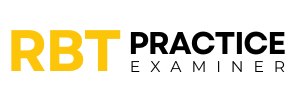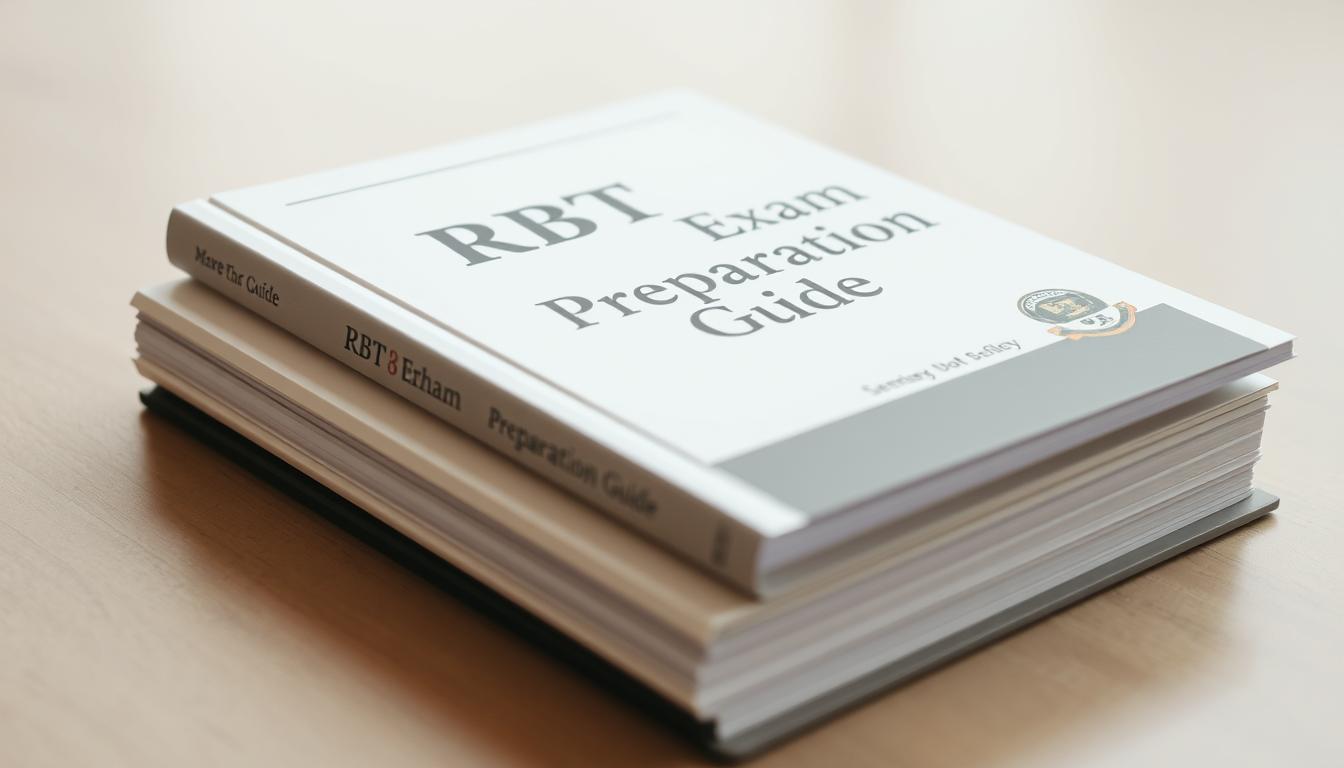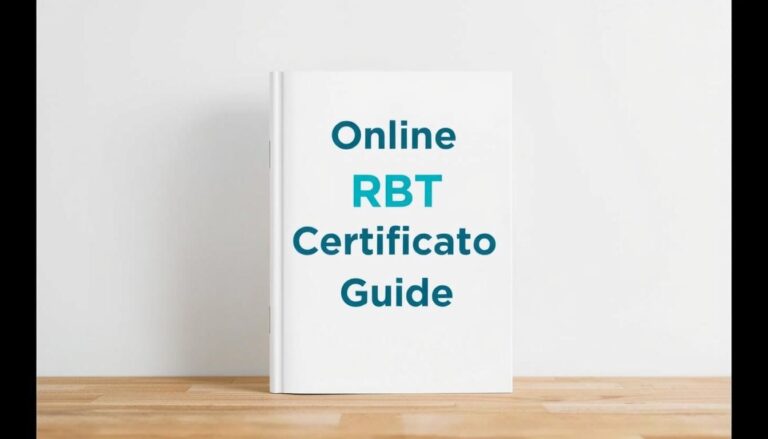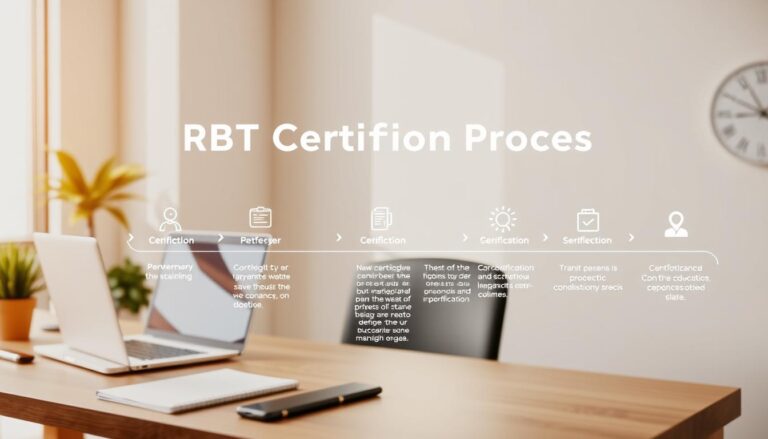How to Take RBT Exam: A Step-by-Step Guide
Becoming a Registered Behavior Technician (RBT) is an exciting career choice. It’s for those who love helping people with autism and behavioral issues. The RBT exam is a big step in your career, needing careful prep and a smart plan.
Getting through the RBT certification process might seem tough. But with the right help, you can ace the exam. This guide will show you how, from knowing what the exam needs to studying smart.
If you want to take the RBT exam, you need to know the whole process. Our detailed guide will lead you through, covering exam needs, study tips, and keeping your certification up to date. It’s all about setting you up for success in this caring field.
Future RBTs will find a clear path to getting certified. We’ll explain each key part of the RBT exam process. You’ll get the info and tools you need to do well in your career.
Understanding the RBT Certification Process
Entering the world of applied behavior analysis opens exciting pathways for professionals dedicated to supporting individuals with developmental challenges. The registered behavior technician exam represents a critical milestone for those seeking to make a meaningful impact in behavioral healthcare.
Registered Behavior Technicians (RBTs) play a key role in implementing behavior intervention plans. They work under the direct supervision of Board Certified Behavior Analysts (BCBAs). Their work is essential in helping individuals with autism and other developmental disabilities develop essential life skills.
What is a Registered Behavior Technician?
An RBT is a paraprofessional who works directly with clients. They implement behavior intervention strategies designed by certified analysts. These professionals undergo rigorous training to ensure high-quality, ethical care in various settings such as:
- Schools
- Clinics
- Home-based programs
- Community centers
Benefits of RBT Certification
Pursuing the RBT certification exam offers numerous professional advantages:
- Enhanced career opportunities in behavioral healthcare
- Competitive salary
- Professional credibility
- Structured career development path
Career Opportunities for RBTs
Certified RBTs can explore diverse career paths within applied behavior analysis. The registered behavior technician exam serves as a gateway to multiple professional settings. This includes specialized autism support, educational intervention, and therapeutic program implementation.
Professionals who successfully complete the RBT certification exam demonstrate their commitment to providing high-quality behavioral support. They open doors to meaningful career growth in healthcare and education.
Essential RBT Exam Requirements and Eligibility Criteria
To become a Registered Behavior Technician (RBT), you must meet certain requirements. These ensure you’re ready and skilled for the job. Before you start, make sure you understand the eligibility criteria.
The criteria for the RBT exam include several important points:
- Minimum age requirement of 18 years
- High school diploma or equivalent educational credential
- Completion of a 40-hour training program approved by the Behavior Analyst Certification Board (BACB)
- Passing a criminal background check
Candidates go through a detailed screening process. This is to make sure they can offer top-notch behavioral intervention services. The background check is a big part of this, aimed at keeping vulnerable people safe.
The training is very thorough. You need to finish a 40-hour program that teaches key skills in applied behavior analysis. A Board Certified Behavior Analyst (BCBA) must supervise your training to confirm your skills.
Here’s what you’ll need for the RBT exam:
- Completed training verification form
- Valid government-issued photo identification
- Proof of completed background screening
- Signed attestation of requirements
Note: Meeting these rbt exam eligibility criteria is key to starting a career in behavioral intervention.
How to Take RBT Exam: Key Steps and Procedures
Getting ready for the RBT exam can seem tough. But with the right help, you can get ready for this big step. Knowing how to take the RBT exam means planning well and following certain steps.
To become a Registered Behavior Technician, you need to follow a few key steps. These steps make sure you’re ready for the exam.
Creating Your BACB Account
Your first step is to make an account on the Behavior Analyst Certification Board (BACB) website. Here’s what you need to do:
- Visit the official BACB website
- Click on the “Create Account” button
- Provide accurate personal information
- Verify your email address
- Complete your professional profile
Scheduling Your Exam Date
After setting up your BACB account, you’ll schedule your RBT exam. Here are some important things to think about:
- Select a convenient testing center location
- Choose a date that allows enough time to prepare
- Make sure you meet all the eligibility requirements
- Pay the exam fee
Testing Center Protocols
Getting ready for the exam day means knowing the rules of the testing center. Being well-prepared is key for a smooth test experience.
- Bring two forms of valid government-issued identification
- Arrive at least 30 minutes before your scheduled time
- No electronic devices are allowed in the testing area
- Dress comfortably but professionally
By following these steps for RBT exam registration, you’ll be ready to pass your certification.
RBT Exam Cost and Financial Considerations
Understanding the cost of the RBT exam is key for those wanting to become Registered Behavior Technicians. The fees for the RBT exam can change based on a few important factors. These are things that candidates should think about carefully.
The Behavior Analyst Certification Board (BACB) sets a standard fee for the RBT exam. Usually, candidates spend between $150 to $200 for the first test. This cost covers the basic test and doesn’t include extra study costs.
- Initial RBT exam fee: $150-$200
- Background check costs: $20-$50
- Training program expenses: $100-$300
- Renewal fees (annual): $50-$100
Planning your finances for the RBT exam is more than just the test fee. You also need to budget for other costs like:
- Mandatory 40-hour training program
- Required background screening
- Study materials and practice tests
- Potential retake expenses
Pro tip: Some employers offer partial or full reimbursement for RBT exam fees and training costs. Check with your current workplace or future employers about financial support options.
There are ways to manage the cost of becoming an RBT. Look into scholarships, professional development grants, or payment plans from training providers. These can help lower your expenses.
RBT Training Program Requirements
To get ready for the RBT certification exam, you need a thorough training. This training must meet strict professional standards. It’s for those who want to become Registered Behavior Technicians.
The Behavior Analyst Certification Board (BACB) sets clear rules for RBT test prep. You must go through a structured training. It teaches you key behavioral intervention techniques and your professional duties.
Approved Course Content
A good RBT training program has many modules. They cover:
- Ethical considerations in behavioral intervention
- Measurement and documentation of behavioral data
- Implementation of behavior reduction strategies
- Skill acquisition and teaching techniques
- Professional conduct and communication
Finding Accredited Training Programs
When picking a training program, look for:
- BACB-approved training providers
- Programs with experienced behavior analysts
- Comprehensive curriculum matching the RBT task list
- Flexible learning options (online or in-person)
Documentation Requirements
Good RBT test prep means keeping detailed records. You need to have:
- Verified training hours log
- Signed competency assessment forms
- Proof of completed training program
- Background check documentation
Pay close attention to your documentation. It helps you get RBT certified smoothly. It shows your dedication to quality behavioral intervention.
Mastering the RBT Task List
Getting ready for the Registered Behavior Technician (RBT) exam means knowing the RBT Task List well. This key part of your study guide is like a map for your exam prep and career growth.
The RBT Task List lists important skills and areas of focus for behavior technicians. It details specific tasks that show you’re good at applied behavior analysis.
- Measurement of behavior
- Assessment and documentation
- Skill acquisition
- Behavior reduction
- Professional conduct and ethical considerations
When you’re studying for your RBT exam, focus on these main areas. Each task needs deep understanding and real-world practice. Good candidates learn in a way that’s more than just memorizing.
Here’s how to prepare well:
- Study the official BACB task list carefully
- Practice with scenarios that show what you’ll face in the job
- Get advice from those who have been there
- Use different study tools
Your success comes from a smart study plan. With practice, hard work, and a clear study method, you’ll feel ready for the RBT exam.
Essential Study Materials and Resources
Getting ready for the RBT exam needs careful planning and good study tools. People who pass use many study materials to feel sure about their answers.
The right study guide is key to your prep plan. Here’s a list of top resources to help you learn.
Recommended Study Guides
- BACB Registered Behavior Technician Task List
- Behavior Analyst Certification Board official materials
- Specialized RBT exam preparation books
- Digital downloadable study guides
Online Practice Tests
Practice tests help you get used to the exam format and find what you need to work on. Here are some top sites:
| Platform | Features | Price Range |
|---|---|---|
| Behavior Development Solutions | Comprehensive practice questions | $50-$100 |
| RBT Exam Prep | Detailed explanations | $75-$150 |
| ABA Wizard | Mobile-friendly practice tests | $40-$90 |
Study Groups and Forums
Learning with others can make you understand better and stay motivated. Look into:
- BACB official community forums
- LinkedIn professional groups
- Facebook RBT study groups
- Reddit ABA professional communities
Pro tip: Mix different study tools for the best prep.
Exam Format and Structure Overview
Knowing the format of the registered behavior technician exam is key to getting ready. It tests a candidate’s knowledge and skills in applied behavior analysis (ABA). This is done through a detailed testing method.
The exam uses a structured multiple-choice format. It checks if a candidate can handle behavior intervention and professional practices well.
- Total number of questions: 85 (including 75 scored questions and 10 unscored pilot questions)
- Exam duration: 2 hours
- Computerized testing format
- Proctored examination at authorized testing centers
Candidates will face various question types. These test their practical understanding of behavior analysis. The types include:
- Scenario-based questions testing real-world application
- Theoretical knowledge assessment
- Practical intervention strategy questions
The scoring system for the registered behavior technician exam aims to fully evaluate a candidate’s professional skills.
| Exam Component | Percentage of Total Score |
|---|---|
| Measurement and Data Collection | 20% |
| Assessment and Intervention | 40% |
| Documentation and Professionalism | 25% |
| Ethical Considerations | 15% |
To pass, candidates must show they understand behavior analysis well. They also need to apply it in real work settings.
Time Management Strategies During the Exam
Effective time management is key to success in the RBT exam. It’s about balancing speed and accuracy. You also need to show your knowledge of behavior technician skills.

Getting through the exam well needs a good plan and focus. You should have a clear strategy to do your best and reduce stress.
Pacing Techniques for Optimal Performance
Smart pacing is vital for good RBT exam results. Here are some tips:
- Set time for each question section
- Read questions quickly but carefully
- Move on from hard questions and come back
- Keep a steady pace all through the exam
Question Priority System
Creating a question priority system is important. Your plan should be:
- Do easy questions first
- Mark hard questions for later
- Use the rest of the time for tough questions
Break Management Strategies
Managing breaks well can keep your mind sharp during the exam. Use breaks to:
- Stretch and loosen up
- Drink water and have a snack
- Do quick breathing exercises
- Clear your mind and focus again
Success in the RBT exam is not just about knowing things. It’s also about staying mentally strong and thinking strategically.
| Time Management Strategy | Key Benefits |
|---|---|
| Systematic Pacing | Ensures complete exam coverage |
| Question Prioritization | Maximizes your score |
| Effective Break Use | Keeps your mind sharp |
Common RBT Exam Topics and Concepts
To pass the Registered Behavior Technician (RBT) exam, you need to know a lot about behavioral analysis. You must practice with rbt exam questions to show you’re ready. This means studying the most important areas that show you’re a pro.
The exam looks at several key areas. It checks if you know how to apply behavior analysis in real life. You need to know a lot of core skills to get through the RBT certification.
- Behavior Assessment: Learning how to gather and use behavioral data
- Skill Acquisition: How to teach new skills and encourage good behavior
- Behavior Reduction: Ways to handle tough behaviors
- Professional Conduct: Following ethical rules and standards
- Documentation: Keeping accurate records and reports
When you practice for the rbt exam, focus on using what you know, not just memorizing. The exam wants to see if you can use what you’ve learned in real situations. You need both book smarts and practical skills.
Good test-takers really get how behavioral interventions work. They know why data collection is key and the ethics of being a behavior technician. A smart study plan that covers these areas will help you pass the RBT exam.
Practice Test Strategies and Tips
Getting ready for the RBT exam needs a smart plan and focused study. It’s not just about reading books. A solid strategy can really help you pass the test.
Learning from rbt exam practice questions is all about knowing your strong and weak points. The right study methods can make your learning better and more confident.
Mock Exam Resources
Choosing good practice materials is key for exam prep. Here are some top picks for RBT exam practice:
- BACB official practice exams
- Online training platforms with lots of questions
- Professional ABA certification prep websites
- Registered Behavior Technician study guides
Performance Analysis
Keeping track of your progress is important. Use these tips to check your test results:
- Make a detailed log of your mistakes
- Spot patterns in your errors
- Track your accuracy in different areas
- Time how long you take to finish practice tests
Improvement Techniques
Make your weak spots stronger with specific improvement methods:
| Technique | Description |
|---|---|
| Focused Review | Dive deep into hard topics |
| Spaced Repetition | Regularly review tough concepts |
| Simulation Practice | Do full mock exams like the real thing |
Pro tip: Keep practicing and learning smartly to ace the RBT exam. Stay committed and use a methodical approach.
Testing Day Preparation Checklist

Getting ready for your RBT exam needs careful planning. A detailed checklist helps you know what to do on test day. It makes sure you’re all set for the exam.
Before you go to the testing center, collect all important documents and items. Being well-prepared can boost your exam score and lower stress levels.
- Required Documents
- Valid government-issued photo ID
- Exam confirmation letter
- Printed proof of registration
- Personal Items
- Water bottle
- Light snack
- Comfortable layers of clothing
- Mental Preparation Strategies
- Get a good night’s sleep
- Eat a nutritious breakfast
- Review key concepts briefly
Pro tip: Arrive at the testing center at least 30 minutes early to complete check-in procedures and calm your nerves.
Knowing the testing environment is key when learning how to take the RBT exam. Wear comfortable, yet professional clothes. This helps you stay focused on the exam without distractions.
Stay calm and confident. Your hard work and knowledge will help you pass the exam.
Managing Test Anxiety and Stress
Getting ready for the Registered Behavior Technician (RBT) exam can make you feel really stressed and anxious. It’s not just about studying. You also need to take care of your mind and feelings.
First, figure out what makes you anxious. Many people get really nervous because the exam is a big deal for their career.
- Recognize physical symptoms of test anxiety
- Develop personalized coping mechanisms
- Practice relaxation techniques
- Create a structured study routine
Relaxation techniques can really help lower your test anxiety. Deep breathing exercises, meditation, and visualization can calm you down and help you focus better.
Getting mentally ready is key. Positive thinking and building your confidence can turn anxiety into something useful. Just remember, you’ve got this because of all your hard work.
| Stress Management Technique | Benefits |
|---|---|
| Mindfulness Meditation | Reduces anxiety, improves concentration |
| Regular Exercise | Releases stress, boosts mental clarity |
| Adequate Sleep | Enhances cognitive function, emotional regulation |
Getting help from a counselor or joining a support group can give you more ways to deal with test stress. It’s okay to feel nervous. The important thing is to use that energy well during your RBT test prep.
Understanding Scoring and Results
Getting your RBT certification exam results can be confusing. Knowing how scoring works helps you prepare better and understand your performance.
The RBT certification exam tests your knowledge of important skills for a behavior technician. Your score shows if you pass the exam.
Passing Score Requirements
To pass the RBT certification exam, you need to meet certain scores:
- Minimum passing score: 80%
- Total exam questions: 75 multiple-choice items
- Passing threshold: 60 correct answers
Retake Policies
If you fail the RBT certification exam, the Behavior Analyst Certification Board (BACB) has rules:
- First unsuccessful attempt: Immediate retake not permitted
- Waiting period: 24-hour mandatory break
- Maximum retake attempts: Up to 3 times within a 12-month period
Score Report Interpretation
Understanding your score report is key for better preparation. The report usually has:
| Report Component | Details |
|---|---|
| Overall Score | Percentage of correct answers |
| Domain Breakdown | Performance across different skill areas |
| Specific Weakness Areas | Sections needing more study |
Reviewing your RBT certification exam results helps you see your strengths and weaknesses. This is important for future attempts.
Post-Exam Steps and Certification Maintenance

After you pass the rbt certification exam, many steps follow. It’s not just about passing the test. It’s the start of your career as a Registered Behavior Technician.
Your first step is to register with the Behavior Analyst Certification Board (BACB). You need to send in your exam results and check your credentials. Remember, your certification is good for one year, so you must keep it up to date.
- Submit official exam documentation to BACB
- Pay the initial certification fee
- Complete background check requirements
- Maintain supervision from a qualified BCBA
To keep your RBT certification, you must stay committed. You’ll need to do annual renewal tasks. These include:
- Continuing education courses
- Ongoing professional supervision
- Passing an annual competency assessment
- Renewing your certification before it expires
Professional growth is key to success in the RBT certification exam pathway. Keep up with new behavioral intervention methods. This will help you grow in your career in applied behavior analysis.
Conclusion
Getting ready for the RBT exam takes hard work and smart planning. It’s all about knowing what to do to pass. You’ll need to learn a lot, study hard, and keep growing in your field.
Getting certified is a big challenge. You must be disciplined and pay close attention to every detail. By learning the task list, using good study tools, and managing your time well, you can do great on the exam. Remember, it’s not just about passing a test. It’s about helping people with behavioral issues.
Feeling confident about the RBT exam means you know you’re getting better with each step. The skills you gain will help you in your career. Stay focused, be patient, and believe in your preparation to become a top Registered Behavior Technician.
Your effort to get certified shows you really care about helping others. Keep learning, stay motivated, and go into the RBT exam knowing you’re ready to succeed.







